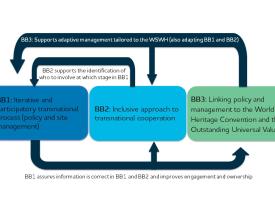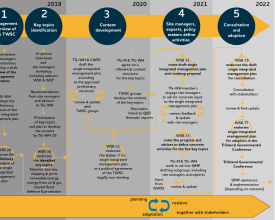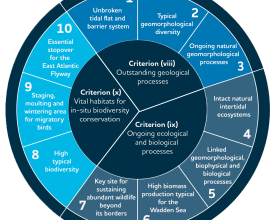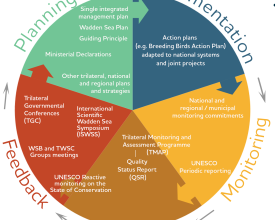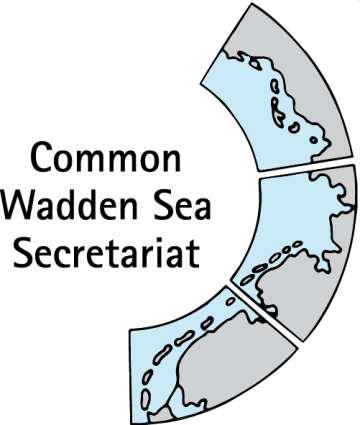
Participatory development process of the single integrated management plan for the transnational Wadden Sea World Heritage site (SIMP)

The single integrated management plan (SIMP) is an umbrella plan for the transnational UNESCO Wadden Sea World Heritage site (DK, DE, NL) and complements the Wadden Sea Plan (2010) which contains the trilaterally agreed targets and policies. With the development of the SIMP, the Trilateral Governmental Cooperation on the protection of the Wadden Sea (TWSC) follows the official request made by the World Heritage Committee in 2014. The plan was developed in an iterative and participatory way in the TWSC including policy and site management levels transnationally. Its purpose is to further facilitate the continuous improvement of transboundary management coordination for the protection and maintenance of the Outstanding Universal Value of the Wadden Sea World Heritage site.
Context
Challenges addressed
- Differences in political and administrative structures and generally accepted management practices between the three Wadden Sea countries (for example interpretation and implementation of EU law into national legislation, competencies of nature protection administrations, and non-governmental site managers) present challenges in complying with the expressed political intentions of managing the Wadden Sea World Heritage as ONE common entity.
- Effective management of the Wadden Sea World Heritage needs to address key activities affecting the property in an integrative way, including the most important economic activities, whilst safeguarding the site’s Outstanding Universal Value (OUV).
Location
Process
Summary of the process
An iterative and participatory method is the base and main principle to develop a successful SIMP. This not only allows to put together the most current and correct information, but it promotes the flow of information between policy and site management trilaterally. BB1 provides the necessary base to build a proper inclusive approach for transnational cooperation (BB2) as well as supports building a shared understanding of linking policy and management to World Heritage requirements (BB3). BB2 enables the right levels and stakeholders to be identified and involved in the process (BB1) and BB3 informs and guides the process (BB1) to adapt policy and management when necessary.
Building Blocks
Iterative and participatory nature conservation planning process (site management and policy levels)
The purpose is to achieve a successful transboundary management plan integrating the levels needed for effective management. An exercise to imagine what would make the SIMP a success was useful to manage expectations, and guide and adapt the process.
- Preparatory phase: the trilateral Task Group World Heritage, overseeing the SIMP development, agreed on the purpose to improve management coordination at the trilateral level. Considering the suggestions from site management and policy levels and the Operational Guidelines for the implementation of the World Heritage Convention, a roadmap and content were agreed upon.
- The content development in the TWSC: draws upon the existing governance of the cooperation. The working groups supported the drafting of the SIMP’s content in regard to climate change effects and adaptation, education, sustainable tourism, research, monitoring, assessment, etc. Preliminary content was iteratively reviewed and enriched by the TWSC groups, the site managers, the trilateral Task Group World Heritage, and the Wadden Sea Board.
- Consultation beyond the TWSC: external stakeholders, and members of advisory boards in each of the German Federal States, Denmark, and the Netherlands, reviewed and commented on the draft SIMP.
A similar process is foreseen for assessing the progress and adapting activities.
Enabling factors
- The existing governance structure of the TWSC includes working groups on relevant topics to the Wadden Sea World Heritage and therefore the single integrated management plan (SIMP). The mandate to develop the SIMP (involving site management and policy level) was given in the Trilateral Governmental Declaration as a response to the request of the World Heritage Committee.
- Existing engagement of the Task Group World Heritage.
- Resources commitment from the parties and an additional staff member in CWSS as SIMP project officer.
Lesson learned
- Give enough time for participation: take into account that each country has its own participation habits and structures and that each involved group has its own rhythm and processes to follow. Learn about those and integrate these the best as possible.
- Plan for discussions among the involved parties: some aspects require more time and background information to understand positions and propose solutions. The Trilateral Task Group World Heritage was a great platform with members that are the liaison to the policy and site management level.
- Effective, easy, tailored communication is key at all levels and all phases in order to convey the key messages. Here we learned along the way and improved but more improvement is possible.
Inclusive approach to transnational cooperation
The purpose is to have a good transboundary understanding of the national nature conservation systems and how the people and organisations involved work together on a trilateral level. This deep understanding supports the improvement of the implementation of coordinated management and the linking of national to trilateral (and vice-versa) policies, plans, and activities.
In the Trilateral Governmental Cooperation, each country has its own political culture and priorities. This has an influence on the governmental and civil society structures and thus on decision-making processes, which in turn influences nature conservation and management.
The national nature conservation structures clarify which are the different public organisations and the different geopolitical levels that are responsible for planning, policy-making, and implementing nature conservation activities on the ground. Also required was a definition of nature conservation site managers, their roles, and competences per country. These elements are key to consider while developing a transnational integrated management plan (SIMP).
All the groups with competences in nature conservation are represented in the trilateral governance structure. Some at the decision-making body the Wadden Sea Board, and others in the different working groups.
Enabling factors
It is in the interest of governmental organisations involved in nature conservation to express and clarify their roles and competences at the national level. This helps to manage and adjust expectations as well as for designing a trilateral structure including the relevant non-governmental organisations and groups.
Lesson learned
- It is not always easy to understand the management structures and processes because of the different political cultures in the three countries. It is good to have people that can “translate” structures into a “common language”.
- Good to have the correct, clear, and complete structures to make sure that in the process of developing the single integrated management plan we are involving the right organisations at the right stages in the transnational iterative and participatory process (see BB1).
- Understanding the structures also supports the understanding of the process of policy making, management plans related to EU Directives, and the update of national strategies and agendas, easing the spotting of important moments to consider nationally trilateral policies, strategies, and plans with the TWSC members help.
- Understanding the national nature conservation structures and processes also helps to improve the understanding of how other national and regional commitments (a.o. EU Directives and Strategies) are being implemented in each country.
Linking policy and management to the World Heritage Convention and the Outstanding Universal Value
The purpose is to add World Heritage-specific criteria and values to complement the existing nature conservation management, thus emphasizing that the World Heritage designation is the utmost international acknowledgment for a natural area.
The Operational Guidelines for the Implementation of the World Heritage Convention (§ 111) state that an adaptive management cycle of planning, implementation, monitoring, evaluation, and feedback is among the elements of effective management. In the SIMP development process, the existing TWSC management instruments (activities, policies, plans, and strategies) are organised and visualised in the corresponding phases of the adaptive management cycle (see graph).
To assess existing and potential positive and negative effects on the Outstanding Universal Value (OUV) of the Wadden Sea World Heritage, ten key values were identified from the three criteria met by the Wadden Sea (method used in the Climate Vulnerability Index). A rapid expert assessment of the positive and negative effects of the SIMP key topics on each of the ten OUV key values supported the discussions of potential management activities (see graph).
Enabling factors
An index-based rapid assessment of the vulnerability to climate change (Climate Vulnerability Index -CVI) using the OUV key values was done in 2021.
The World Heritage Convention sets out the duties of the State Parties, their roles in protecting and preserving the sites, and provides operational guidance on the Convention’s implementation.
TWSC was established in 1978 as a tool for cooperation and coordination of nature conservation. Denmark, Germany, and the Netherlands have built independently, and jointly a comprehensive management system addressing key aspects.
Lesson learned
- Although much has already been achieved and the work towards important milestones is underway, there are still challenges to be faced.
- On one hand, rapid expert assessments results of the positive and negative effects of the SIMP key topics on the Outstanding Universal Value (OUV) key values, in general, coincide with the results from the discussions and views of the policy and site managers. On the other hand, in-depth studies that can be reviewed and updated regularly are preferred if resources and time are available. To solve this, the Trilateral Wadden Sea Cooperation (TWSC) chose to integrate these assessments with the Quality Status Reports updated periodically by experts.
Resources
Impacts
- Involvement of nature conservation site managers in defining key topics to address and to develop potential trilateral management activities.
- Greater understanding of how each country organises for nature conservation management for the World Heritage site and how they work together trilaterally.
- This process gave the opportunity to the policy and site managers levels to contribute at different stages, increasing the ownership of the SIMP. Members of the trilateral Task Group World Heritage, comprising the official World Heritage site managers, are ambassadors for its implementation.
- The final consultation phase invited stakeholders again to further improve the proposed activities.
- Re-establishes and intensifies long-term dialogue about human uses, considering climate change, biodiversity loss, and ambitious energy transition goals.
- Distribution of the SIMP to a.o. policy makers and at regional levels contributes to raising awareness and understanding for the management of the World Heritage site, and the role of other sectors in its implementation.
- Direct link to the Outstanding Universal Value -OUV: Rapid expert assessment of impacts on the OUV and link to the periodic Wadden Sea World Heritage Quality Status Reports.
- Direct link to the World Heritage Convention’s adaptive management cycle.
- The SIMP contributes to the implementation of relevant EU regulations by formulating potential management activities.
Beneficiaries
In the short term, the Wadden Sea and the TWSC are the main beneficiaries of the SIMP. In its implementation, hopefully the communities associated with the site, other sectors and stakeholders see an added value in being involved.

